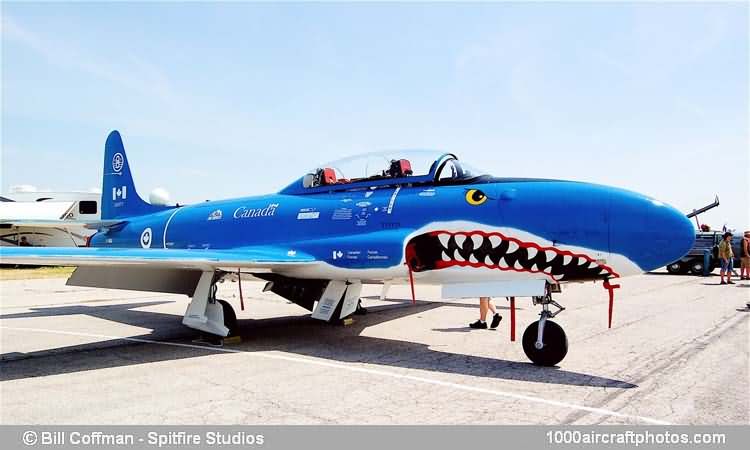01/31/2012. Remarks by Johan Visschedijk: "With the general switch to jet-powered aircraft the RCAF needed a jet trainer and selected the Lockheed T-33A and in 1951 ordered 20 of them, designated Silver Star 1 (s/n 14675 to 14694). At the same time it asked Lockheed Aircraft to make a Rolls-Royce Nene powered version and Lockheed adapted USAF 51-4198 to take the Nene and delivered it to the RCAF with s/n 14695, the sole Silver Star 2, in November 1951. The RCAF also obtained the license to build a Nene-powered version, designated T-33AN Silver Star 3, and with Canadair designation CL-30.
The Lockheed T-33, or 'T-bird' as it was commonly known, was a stretched trainer version of the Lockheed P-80, the first United States jet to go into general operational use. It carried a crew of two in tandem in a pressurized cockpit and could be used for either pilot or armament training. For armament training, the T-33AN could be fitted with two 0.50 in (12.7 mm) Browning machine guns in the nose, and underwing stores could include sixteen 5 in (12.7 cm) rockets or two bombs of up to 1,000 lb (454 kg) each. Both versions carried 353 gal (1,336 l) of fuel internally, and normally tip tanks with another 460 gal (1,741 l) as well.
The aircraft was of conventional aluminum stressed-skin construction, with split flaps, and an hydraulically-operated retractable landing gear. The Nene-powered version was appreciably heavier than the T-33A, and the Nene produced an extra 500 lb (227 kg) static thrust over the Allison J-33-A-35, enhancing its performance. With the exception of the Lockheed-converted prototype all Nene-powered T-33s were made by Canadair.
Canadair's contract for 656 T-33AN Silver Stars (c/n T-33-1 to T-33-656, RCAF s/n 21001 to 21656) was announced on 13 September, 1951, and work started immediately. Two hundred sets of wings were obtained from Beech Aircraft Corp of Wichita, and subcontracts were placed in Canada for rear fuselages, tail units and intake ducts. Most of the Nenes were supplied from Britain but some were built by Rolls-Royce of Canada, and in the beginning two came from Hispano-Suiza.
The Canadian prototype, RCAF 21001, was first flown at Cartierville on December 22, 1952, by William S. Longhurst, and was delivered to the RCAF the following January. Production built up steadily and by December 1953 had stabilized at 1.5 aircraft a day. The type served the RCAF well as a trainer but was best known to the general public as the mount of the RCAF aerobatic soloist who appeared with its aerobatic team each year. It was painted a brilliant red and called Red Knight.
As part of the MAP Canada gave T-33ANs to Bolivia, France, Greece, Portugal, and Turkey. Two civil registered T-33ANs, CF-SKH-X and CF-WIS-X, were operated by the National Aeronautical Establishment at Ottawa. They carried a large, specialized, instrument package in their noses and are used for environmental research. Flight Systems Inc. of Mojave, California, USA, also used a number for research and as test beds.
After the merger of the RCAF into the CAF, the type was redesignated from T-33AN to CT-133 and the survivors were renumbered in the 133000 range, the first three digits (133) being followed by the three digits of the c/n. A number of aircraft appeared on the civil registries of several countries, including Canada, the UK and the USA, while also several museums acquired a number for display.
The pictured aircraft was delivered to the RCAF with the s/n 21577, renumbered in the CAF as 133577 on November 11, 1970. After 2000 the aircraft appeared on the US register as N577KK, it was deregistered on January 16, 2008, and exported to Canada, where it was registered as C-FRGA on March 26. In April 2011, this aircraft was painted as 'Silver Shark', the scheme worn by the CT-133 with s/n 133504 (c/n T33-504) of Utility Squadron VU-32 of CFB Shearwater in 1992, in relation to the squadron's disbandment in the summer of that year."
